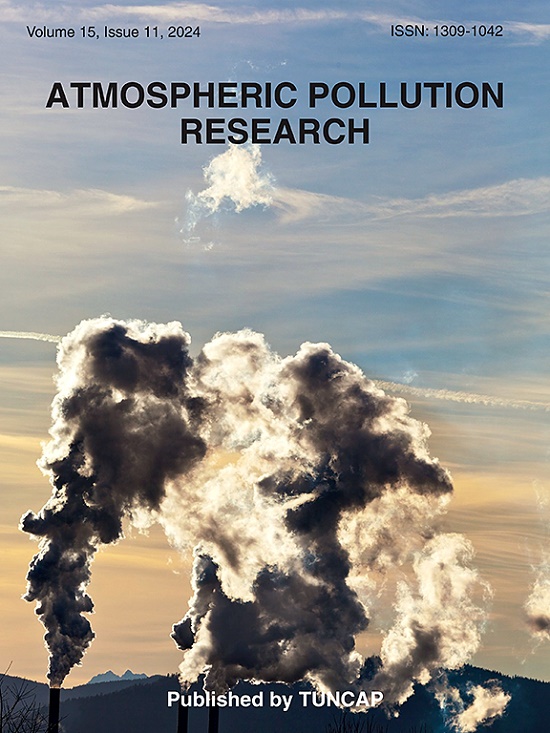Inter-model comparison of the DRI-2001 and DRI-2015 for carbonaceous aerosol analysis in PM2.5: Method development and application in Chongqing
IF 3.5
3区 环境科学与生态学
Q2 ENVIRONMENTAL SCIENCES
引用次数: 0
Abstract
Thermal-optical method is widely used to determine organic carbon (OC) and elemental carbon (EC) in PM2.5 collected on filters. DRI-2001 and DRI-2015 analyzers have both been extensively employed with the IMPROVE_A protocol in the recent decades. However, differences in detectors and lasers between the two models can affect the measurement results. In this study, a novel using multiple linear regression was developed to equalize carbon fraction results between DRI-2001 and DRI-2015. After adjustment, high inter-model consistency was observed, with a mean bias within 5 % for total carbon (TC) and OC, and ∼10 % for EC. Larger inter-model differences (5.2 %–121.5 %) were found in OC1-OC4 and EC1-EC3. Fractions with high mass loading, particularly those linked to biomass burning (BB) and coal combustion (CC) (e.g., OC1, OC2 and OC4), exhibited better agreement after adjustment, with smaller mean bias within ∼15 % and higher R2 values above 0.93 (p < 0.001). During winter in Wanzhou, the adjusted carbon fractions exhibited significantly improved inter-model agreement (p < 0.001). BB and CC were identified as the primary sources of carbonaceous aerosol, while secondary organic carbon (SOC) also contributed to elevated TC concentrations during pollution periods. Similar to DRI-2001 results, DRI-2015 measurements during winter indicated that CC and BB contributed 47.5 %, diesel exhaust 18.0 %, gasoline exhaust 21.6 %, and secondary formation 12.9 % to TC. These findings enhance our understanding of uncertainties and differences between models, leading to more accurate characterization of carbonaceous aerosol.
DRI-2001和DRI-2015对PM2.5中碳质气溶胶分析的模式间比较:方法开发与在重庆的应用
热光学法被广泛用于测定过滤器收集的PM2.5中的有机碳(OC)和元素碳(EC)。近几十年来,dr -2001和dr -2015分析仪都被广泛应用于IMPROVE_A协议。然而,两种模型之间的探测器和激光器的差异会影响测量结果。本研究提出了一种新的多元线性回归方法来平衡DRI-2001和DRI-2015之间的碳分数结果。调整后,观察到很高的模型间一致性,总碳(TC)和总碳(OC)的平均偏差在5%以内,总碳(EC)的平均偏差在~ 10%。OC1-OC4和EC1-EC3的模型间差异较大(5.2% - 121.5%)。具有高质量负荷的馏分,特别是那些与生物质燃烧(BB)和煤燃烧(CC)相关的馏分(例如,OC1、OC2和OC4),在调整后表现出更好的一致性,平均偏差在~ 15%以内,R2值高于0.93 (p <;0.001)。在万州冬季,调整后的碳组分在模式间的一致性显著提高(p <;0.001)。发现BB和CC是含碳气溶胶的主要来源,而二次有机碳(SOC)也对污染期间TC浓度的升高有贡献。与dr -2001的结果相似,dr -2015在冬季的测量结果表明,CC和BB对TC的贡献率为47.5%,柴油废气为18.0%,汽油废气为21.6%,二次形成为12.9%。这些发现增强了我们对模式之间的不确定性和差异的理解,从而更准确地表征含碳气溶胶。
本文章由计算机程序翻译,如有差异,请以英文原文为准。
求助全文
约1分钟内获得全文
求助全文
来源期刊

Atmospheric Pollution Research
ENVIRONMENTAL SCIENCES-
CiteScore
8.30
自引率
6.70%
发文量
256
审稿时长
36 days
期刊介绍:
Atmospheric Pollution Research (APR) is an international journal designed for the publication of articles on air pollution. Papers should present novel experimental results, theory and modeling of air pollution on local, regional, or global scales. Areas covered are research on inorganic, organic, and persistent organic air pollutants, air quality monitoring, air quality management, atmospheric dispersion and transport, air-surface (soil, water, and vegetation) exchange of pollutants, dry and wet deposition, indoor air quality, exposure assessment, health effects, satellite measurements, natural emissions, atmospheric chemistry, greenhouse gases, and effects on climate change.
 求助内容:
求助内容: 应助结果提醒方式:
应助结果提醒方式:


